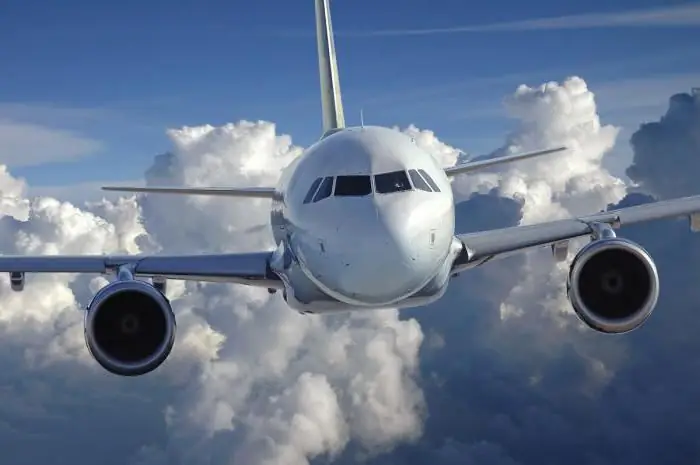- Author Harold Hamphrey [email protected].
- Public 2023-12-17 10:06.
- Last modified 2025-01-24 11:10.
The cockpit occupies the forward part of the hull. It houses pilots, as well as many instruments and sensors that pilots use to control the aircraft.
View from the cockpit of the lagoon is shown below.

Cockpit device
The cockpit for pilots occupies the minimum possible volume, since there is not much space on an airliner. But at the same time, the workplace of each pilot provides free access to the instruments and controls of the vessel, as well as a full view through the glass in the front of the room, the so-called lantern.
Lantern includes two windshields, two sliding windows and two side windows. Windshields have mechanical wipers (like cars) and hydrophobic protection from rain and snow. The strength of the windshields and their mounts is designed for a possible meeting during a flight with birds.
The cabin of a passenger aircraft is separated by a strong armored partition with a lockable door from the rest of its premises.

Flight Crew
Full flight personnel of the aircraft includes:
- ship commander(first pilot);
- co-pilot;
- flight engineer (flight mechanic);
- navigator;
- airborne radio operator.
Today, almost all passenger aircraft have automated flight control with a high degree of reliability. This is achieved through a multi-stage control system.
Therefore, the crew may be less - only two people (1st and 2nd pilots). It depends on the direction and distance of the flight. For example, if radio beacons and flight surveillance systems are provided along the entire route, there is no reason to have a navigator and an airborne radio operator in the flight team.
How do you like the view from the cockpit? Exciting, right?

Accommodation for crew members
In the seat to the left of the entrance is the commander of the ship, to the right is the co-pilot. The flight engineer (if included in the crew) is usually behind the co-pilot's seat, as he must see the signals and signs given by the first pilot.
Aircraft cockpit: equipment layout
The most important and frequently used instruments during the flight are placed in the closest and most convenient zone of visibility and accessibility.
To increase the reliability of the aircraft control, duplication of critical equipment for both pilots is provided.
To control the course of the aircraft manually, the handles located on the side consoles and foot pedals are used.
Directly in front of the pilots is a dashboard with instruments showing flight parameters,navigators, alarms, landing gear control handle, as well as autopilot consoles.
Wings, airbrake, radio navigation and communications are controlled by a central console located between the pilots' seats.

Top console controls systems:
- power supply;
- fuel supply;
- hydraulics;
- conditioning;
- fire safety, etc.
The cockpit has a wardrobe for clothes and things of pilots, a folding table, a place to store documents.
For the convenience of pilots, there are ashtrays, pen and pencil holders, cups, etc. near their workplace
Also, the cockpit is equipped with sets of oxygen masks and life jackets, a first aid kit, an electric torch, an ax, etc.
Cockpit security
Protection of pilots and equipment from attack is provided by:
- strengthening the structure (booking) of doors and partitions;
- special door locks;
- code device;
- video surveillance systems in the passenger compartment.
Crew lounge

Some aircraft make long non-stop flights (more than 15,000 kilometers) and the flight takes over 18 hours.
This places increased demands on the crew in terms of their physical and mental he alth. After all, they have a big responsibility! Hundreds of lives depend onthe correctness of their actions!
So pilots should always be calm and alert.
A number of preventive measures have been developed for this:
- The power sets for them are different, so that in case of possible poisoning of one pilot, the second one could fly the plane.
- There is a rest room, which can be located in the passenger compartment, under it or above it. During the flight, each crew member is en titled to 5 hours of rest (or sleep).






